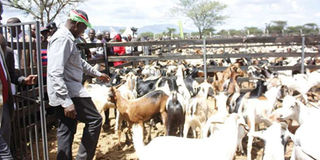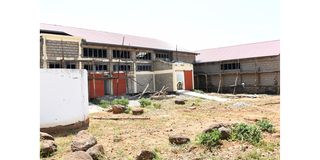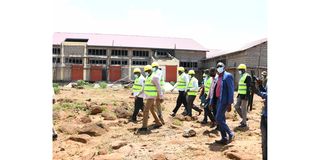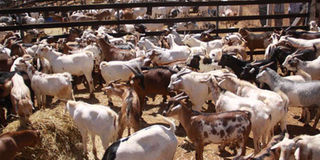Kimalel goat auction to go hi-tech with Sh141m abattoir

Deputy President William Ruto inspects goats at the Annual Kimalel Goat Auction in Baringo County on December 19, 2015. The farmers sold 1960 goats receiving over Sh23 million during the event. Mr Ruto said the new Jubilee Party will unite Kenyans. PHOTO | CHEBOITE KIGEN | NATION MEDIA GROUP
When people talk of Koriema, what comes to mind is the popular meat in Baringo County that is said to be naturally salted.
The meat, according to locals, gained popularity for its succulence, thanks to the red soils in the area and the shrubs that the goats feed on.
The region is commonly referred to as ‘Goat County,’ and visitors normally make a stopover at the famed Koriema shopping centre on the Kabarnet-Marigat road for a bite of the unique delicacy.
To improve the living standards of farmers in the region who depend mostly on livestock keeping as their economic mainstay, the Kimalel goat auction, the brainchild of President Daniel Moi, opened in 1986.
By the time it was stopped, the project had seen over Sh50 million raised from the sale of about 31,863 goats, 2,518 sheep and 180 cows.
The late nominated MP Ezekiel Barng’etuny organised the auction, which saw over 8,000 goats sold in just one day, many of them through bidding.
Goat auction revival
With the advent of devolution, the county government revived the auction in 2014 and introduced a cultural component to make it a fun-filled event, which has seen millions of shillings raised to support farmers.
Now the event is expected to be modernised through the construction of the Sh141 million Maoi slaughter house in Mogotio sub-county, which is expected to start operating in September this year.

Baringo County Director of Livestock Mr Richard Bundotich taking Defence Cabinet Secretary Eugene Wamalwa on a tour of the ongoing construction of the Sh141 million Maoi slaughter house on September 3, 2021.
The multimillion-shilling project funded by the European Union is expected to benefit over 400,000 livestock farmers and traders, accounting for over 60 percent of the total county’s population.
The county’s livestock value chain is expected to improve from the grant, which will attract investment in cottage industries on meat by-products.
The abattoir aims to enhance commerce and improve beef production and subsequently generate income for residents.
Local and export market
Livestock Chief Officer Winnie Bore said that once completed, the slaughterhouse, which targets the local and export markets, will handle more than 1,000 sheep and goats, and 200 cattle and will adopt a sustainable market-oriented strategy.
She said it will help turn around the economy, as it will create a ready market for livestock products and provide employment for more than 30,000 people.
If fully exploited and modernised, it will have a multiplier effect on job creation, generate income at household level, and improve food and nutritional security, Dr Bore said.
“Upon completion, the project will also spur industrial growth through spin-off industries, generate revenue generation and mitigate the perennial insecurity challenge as a result of livestock theft," he said.
“The project will put the county at the forefront to compete with other regional and international markets, which will see our meat branded and certified for quality and safety for sale," he stated.

A section of the multi-million shilling Maoi slaughter house that is expected to benefit over 400,000 livestock farmers and traders, accounting for over 60 percent of the total Baringo county population.
Quality of meat products
Livestock farmers and farmers’ groups in the region have been trained on the best livestock breeding systems and improved production practices such as livestock breed improvement, feedlot farming, pasture and fodder production and conservation.
Governor Stanley Kiptis noted that the project will improve the quality of the county’s meat products.
“We want to major in value addition to improve the quality of our meat products so that during our annual Kimalel goat auction, we do not just sell the live goats but also those slaughtered and delivered anywhere in the country (through online orders),” he said.
The devolved unit has also established livestock sale yards in strategic areas of the county and is collaborating with the State Department of Livestock to establish a holding ground in Chemogoch, Mogotio sub-county.
“These facilities will create opportunities for livestock entrepreneurs in bulking, fattening and finishing livestock for the market that will be readily available at the abattoir,” Dr Bore explained.
Governor Kiptis encouraged livestock producers to improve their production systems so as to benefit from the opportunities that will be created by the project once it starts operating.
He announced that through a partnership with the European Union, the abattoir will open doors for exports of refined meat products.
The county boss said four sale yards have also been set up in Turuturu, Kampi Nyasi, Kinyach and Kalabata.
And in an effort to improve rangeland management of pasture fields, hay sheds have been established in Muchukwo, Kiboi and Kuikui in the Kerio Valley.

County officials on an inspection tour of the multi-million shilling Maoi slaughter house funded by the European Union. It is expected to benefit over 400,000 livestock farmers and traders in Baringo county.
Progress
The governor said the outbreak of the Covid-19 pandemic in 2020 hurt progress on the abattoir.
But he said it is now 96 per cent complete and would start roaring in September.
In order to generate enough raw materials for the abattoir, Governor Kiptis said his administration had distributed more than 30 Sahiwal bulls, 800 Galla bucks and 33 Doper rams to farmers in all sub-counties to upgrade local breeds.
Banking on project
The county government is banking on the project to increase revenue from the livestock sector.

Goats in paddocks during Kimalel goat auction in Baringo County on December 17, 2016. The main sponsors of this year's event are KCB and National Hospital Insurance Fund. PHOTO | JARED NYATAYA | NATION MEDIA GROUP
Governor Kiptis said that because a majority of residents in the region rely on livestock production for their livelihoods, his administration was committed to fully exploiting the sector by providing quality hybrid breeds and doubling pasture production to cushion farmers during droughts.
"Our focus now is on software initiatives that stir economic growth, as opposed to the brick-and-mortar approach to development we are traditionally used to," Mr Kiptis said.
Farmers in the region have consequently been urged to adopt modern methods in order to transform Kenya’s agriculture into a profitable and commercially viable economic activity.
“Farmers should also improve their breeds and work towards a good marketing strategy because it is an important means of growing our economy,” the governor said.
The county, he said, is expansive and half is highland, which is suitable for fodder production.
With the other half being rangeland and ideal for livestock keeping, the sector can create jobs for young people and transform lives if challenges in productivity and market access are addressed.
“To revamp the livestock sector, we have strived to control livestock diseases and pests by carrying out frequent vaccination and keeping markets open to enable farmers to market their animals,” the governor said.
“We have also vaccinated 500,000 animals against peste des petits ruminants (PPR) disease, 100,000 against foot and mouth disease, 130,000 against Rift Valley fever and 2,000 dogs against rabies.”
The county government, in collaboration with partners, has also mounted aggressive surveillance and documentation of disease, helping detect and tackle outbreaks by use of rapid test kits.





